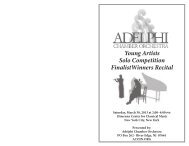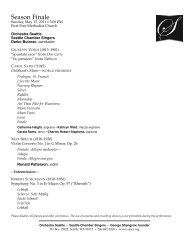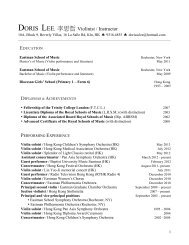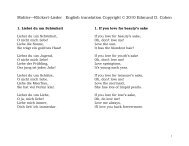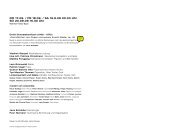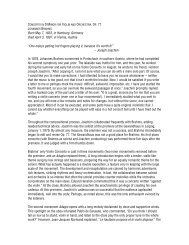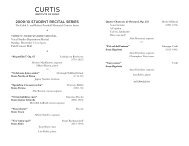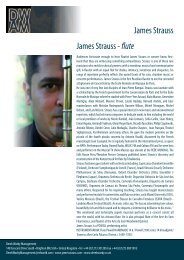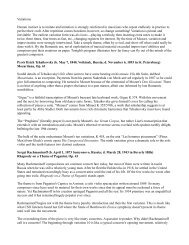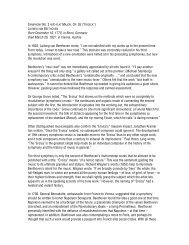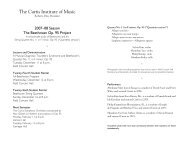Coriolan Overture, opus 62 Ludwig van Beethoven ... - InstantEncore
Coriolan Overture, opus 62 Ludwig van Beethoven ... - InstantEncore
Coriolan Overture, opus 62 Ludwig van Beethoven ... - InstantEncore
Create successful ePaper yourself
Turn your PDF publications into a flip-book with our unique Google optimized e-Paper software.
keys remote from the A-major home base. It is linked to the main Vivace section by the<br />
playful evolution of the galloping dotted rhythm that drives the rest of the movement.<br />
Late in its course, listen for the remarkable passage in which the low strings mutter a<br />
twisting dissonant motive — like an evil worm corrupting the tranquil, sustained<br />
harmony above.<br />
Another persistent rhythmic pattern propels the beloved second movement: a<br />
gentle march beat of long-short-short-long-long. <strong>Beethoven</strong> lets its wonderful theme<br />
gradually unfurl: first the bare-bones tune in low strings, then the stately march melody<br />
above, accompanied by graceful countermelodies. The form is one of <strong>Beethoven</strong>'s own<br />
devising: part rondo, part theme-and-variations. And in a later return of the march theme,<br />
it evolves into a cunning fugue as well.<br />
Movement three is <strong>Beethoven</strong>'s most ebullient and propulsive scherzo, powered<br />
by the relentless chugging of quarter notes in a frenzied Presto tempo. Providing utmost<br />
contrast, the trio section, dominated by woodwinds, is smoothly lyrical over a sustained<br />
pedal note. In a favorite trick, also used in his Fourth Symphony, <strong>Beethoven</strong> runs around<br />
the scherzo-trio track three times, though as the trio begins it third reprise, it falters<br />
harmonically and is roughly dismissed.<br />
The finale is a fierce dance of triumph. Again a rhythmic motive starts the action:<br />
a cannon-boom followed by a three-note rat-ta-tat rifle response. This wild and surging<br />
music has a pronounced military flavor suited to its era. In fact, we hear a theme of<br />
swaggering martial gait early on, and in the coda the trumpets carry it to a ringing<br />
affirmation. Here, <strong>Beethoven</strong> joyfully trounces Napoleon and all the enemies of<br />
humankind.<br />
Notes by Janet E. Bedell copyright 2009



